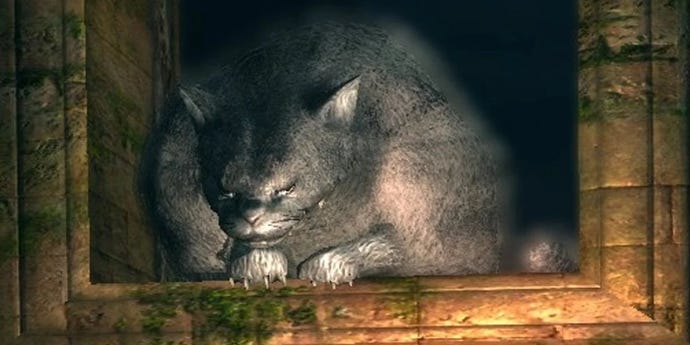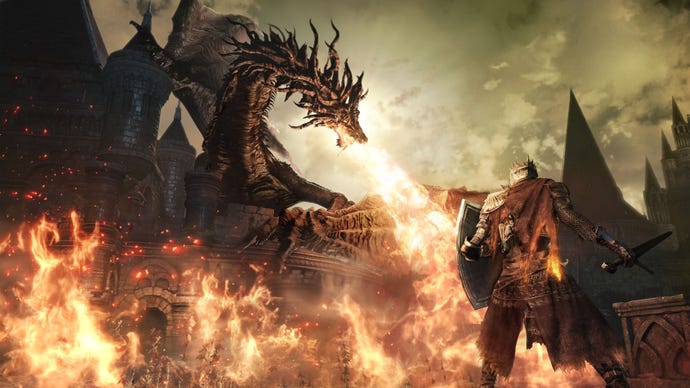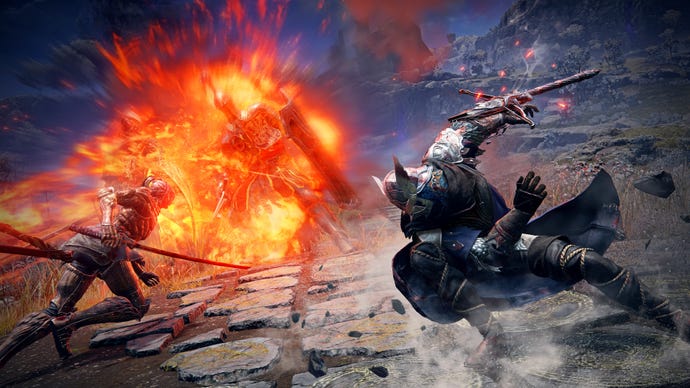Let me start this with the memory that always surfaces when I write about Dark Souls multiplayer – the anecdote I’ve told in several articles, hoping that somebody (you?) will explain. It’s 2011 and I’m making my way through Lordran for the first time. I’m in the woods with my longsword and Grass Crest Shield. There is a glimmer through the trees and another player appears, wearing exotic equipment. I raise my guard, anticipating a swift defeat, but the other player only stands and waves. They beckon me deeper into the wood.
It’s rarely smart to follow a stranger into the woods. I do so anyway, keeping my distance, shield held out like a passport, and am led to a clearing in which another player kneels. The second player does not react to my arrival. The first player gesticulates urgently.
There follows a long, silent exchange of emotes. I bow cautiously, thinking that maybe the other players want me to observe the proper ceremonies before starting the duel. The first player points at the second, kneeling player. I spread my arms in bewilderment. The first player bows, points at the kneeling player and makes chopping motions with their greatsword.

A willing human sacrifice? I feel like if I follow the directions there will be a horrible, Basilisk-grade surprise. But I’m also worried that the first player will attack me if I refuse to play along. I count the souls in my inventory, mull the spawns between here and the last bonfire, then sidle up to the kneeling player and stab them in the ear. They die without protest. The first player is ecstatic, hopping up and down and punching the air. Then they engage me in combat, but in a laidback, amicable way, clearly pulling their punches, as though boxing with a kitten. I kill them with two-thirds left in my health bar and a full bag of Estus. The silence resumes. I am totally confused.
Were these players just jerking around with an obvious noob, or were they operating upon the game’s systems and themes in some devious, unspoken way, enacting some aspect of its mythology that still eludes my grasp? The latter is entirely plausible, because this is Dark Souls, and one of the brilliances of the Souls series is that it makes multiplayer a mystery. Turns it into a story element unravelled, like the rest of the lore, by finding certain items and comparing descriptions. Turns it into a half-witting quest to find particular individuals: the grieving moon beneath the mask of sunlight; the Cheshire grin between the trees, marshalling the warriors of mist.
The broader workings of the recurring soapstone mechanics are tutorialised and easy enough to grasp, but there is so much to learn. For example, the precise relationship between online invasions and the presumption of becoming human, shucking off undeath as though raising your head above a parapet. The elusive Covenants you must forge to become a certain kind of online transgressor. There are forms of multiplayer hidden away in Souls that I never would have guessed, as a newcomer. The chance to become not just an invader but a sentinel, a saviour, a plague, or a terrain fixture. There are dungeons that, as Nic commented to me earlier, enlist online players as the equivalent of a boulder trap.

And then there is the enchantment of the asynchronous online, which makes every location a little disquieting. To play Dark Souls is to be haunted by everybody else playing it. The shades of explorers and the slain pick out the terrain ahead, breeding a range of emotions: schadenfreude when somebody is spiked and hoisted by an unseen spear; gratitude at knowing that the spear is coming; a touch of comedy when you round a corner and walk through a heedless phantom. There are the soapstone messages, written to guide or troll or puzzle you with a reference to something not yet encountered, or not yet manifest.
I love thinking about these entangled multiplayer practices just as much as I love puzzling over backstory considerations like “fire”, “dark” and “disparity”. I love that they have been seized upon and reinvented by communities of online memesters and role-players: the chameleons, the Fashion Souls, the annual sherpas. By extension, I’m a little worried about the direction of FromSoftware’s most recent projects.
As Oscar Wilde wrote, to greenlight one openly multiplayer-driven game may be regarded as an experiment, to greenlight two looks like strategy. Elden Ring Nightreign appears to be an engrossing blend of Soulslike and battle royale, but in presenting itself a class-based co-operative experience upfront, it dissipates a lot of the old romance. It seems to be following through on Elden Ring’s stated goal of making multiplayer more approachable by, amongst other things, replacing the old Covenants with a looser faction system and more generic objectives.

Nightreign is the brainchild of a younger director, Junya Ishizaki, and could be interpreted less generously as a B-team cash-in, smooshing together abilities, models and assets from Elden Ring and the Souls series, while the next, ‘proper’ From game gestates. The just-announced and currently Switch 2 exclusive Duskbloods is being directed by the grossly incandescent Hidetaka Miyazaki himself, and if anything looks even more multiplayer-led. It’s a PvPvE affair for up to eight players which, as Jeremy pointed out to me in Slack earlier, possibly draws on Miyazaki’s enthusiasm for Escape From Tarkov.
Much as you shouldn’t follow strangers into the trees, so you shouldn’t bet against a FromSoftware game. I don’t doubt that Duskbloods and Nightreign will be good. They will probably be great. Nightreign has a mage character who mixes together spells by combining the last three elements an enemy was damaged by. Yep, this is fantastic. All the same, when I play Nightreign and Duskbloods I will be hoping that the multiplayer isn’t all menu option and feature sheet. I will be hoping for buried complications, quirky rites of interaction that take initiative and deduction to expose. I will be hoping for more randos in the woods.
Source link











Add comment